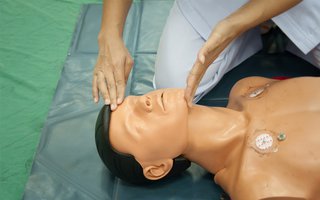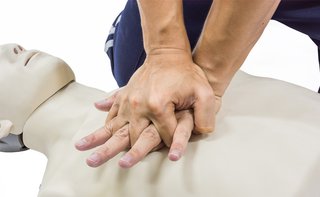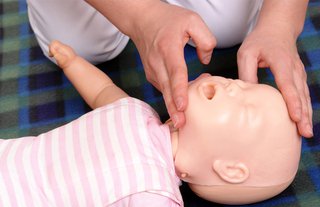Go straight to:
Emergency action required: Call 112 or 999 immediately if:
- your child stops breathing or becomes unresponsive
Ask for an ambulance.
Give them your exact location or Eircode if possible.
Start CPR straight away
CPR is also known as mouth-to-mouth. It's a mix of mouth-to-mouth rescue breaths and chest compressions.
A chest compression is when you apply pressure to someone's chest.
You do this to keep blood and oxygen flowing in the body.
You don't have to do mouth-to-mouth part to save a life, but you must do the compressions.
Do CPR until help arrives
Stay on the phone. The emergency call operator will guide you on what to do next.
They'll give you instructions on how to perform CPR, if it's needed.
It is crucial to continue CPR until paramedics arrive.
Even though you are still on the call, ambulance paramedics are on their way to you.
Giving CPR to a child aged 1 year and older
1. Open the airway
Open your child’s airway by:
- putting one hand on their forehead
- tilting their head back
- lifting their chin
If you can see an object in their mouth or nose, try to remove it.

2. Do 30 chest compressions
Do 30 compressions as follows:
- Place your hands on the centre of their chest.
- With the heel of your hand, press up and down one third of the depth of the chest using one or two hands.
Do the compressions at a steady rate, slightly faster than 1 compression a second. Push hard. Push fast.

3. Give 2 breaths after every 30 compressions
After every 30 chest compressions, give 2 breaths.
Continue with cycles of 30 chest compressions and 2 rescue breaths. Do this until they begin to recover or emergency help arrives.
Giving CPR to babies under 1 year
1. Open the airway
Open your baby's airway:
- Put one hand on their forehead.
- Tilt their head back.
- Lift their chin.
If you can see an object in their mouth or nose, try to remove it.

2. Do 30 chest compressions
Do 30 chest compressions as follows:
- Place two fingers in the middle of their chest.
- Press down one third of the depth of the chest and release.
- Do 30 of these at a steady rate (slightly faster than one compression a second - push hard, push fast).

3. Give 2 breaths after every 30 compressions
After 30 of these chest compressions, give 2 breaths.
Continue with cycles of 30 chest compressions and 2 rescue breaths.
Do this until they begin to recover, an automated external defibrillator (AED) is used, or emergency help arrives.
First aid apps
St John's Ambulance has a free app for your phone.
First aid training
Training in how to give basic first aid to babies and children is available.
Organisations that offer this include:
Irish Red Cross - redcross.ie
Phone: 1890 502 502 (Irish Red Cross)
Order of Malta - orderofmaltaireland.org
Phone: 01 6140035 (Order of Malta)
St John's Ambulance -stjohn.ie
Phone: 01 6688077
CPR training
The Irish Heart Foundation offers certified training in CPR.
Find out more about CPR Courses for the general public - irishheart.ie